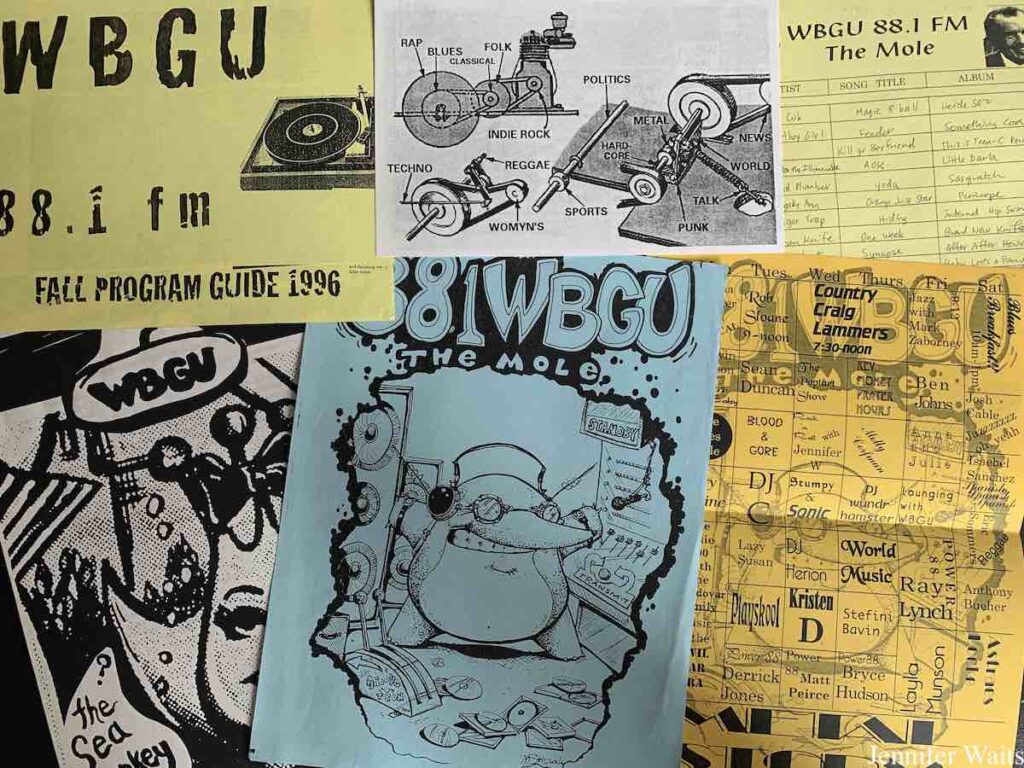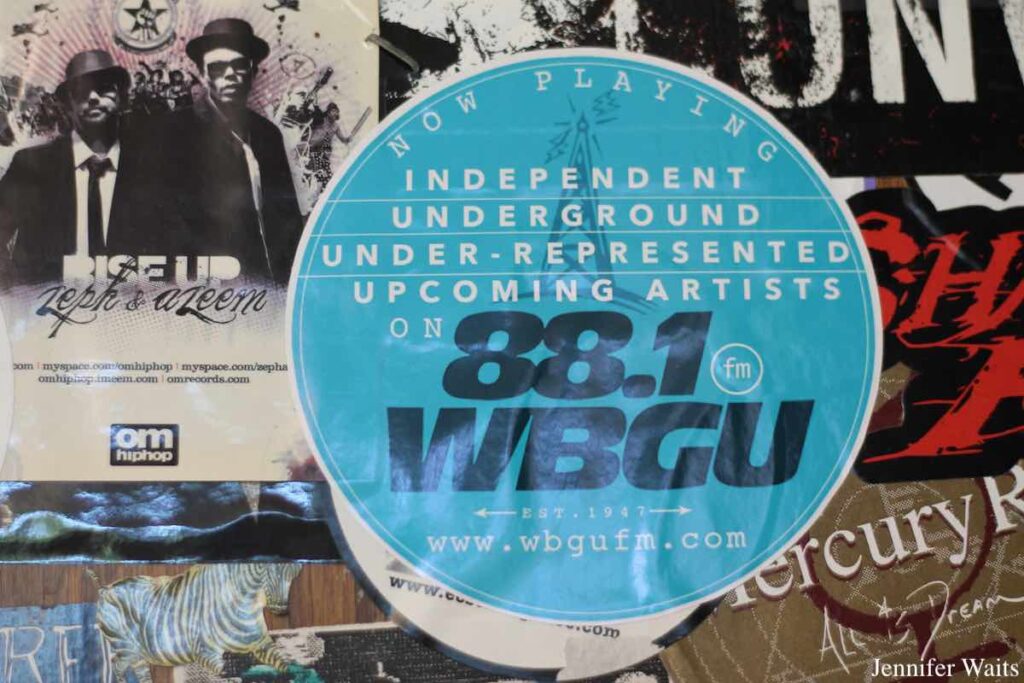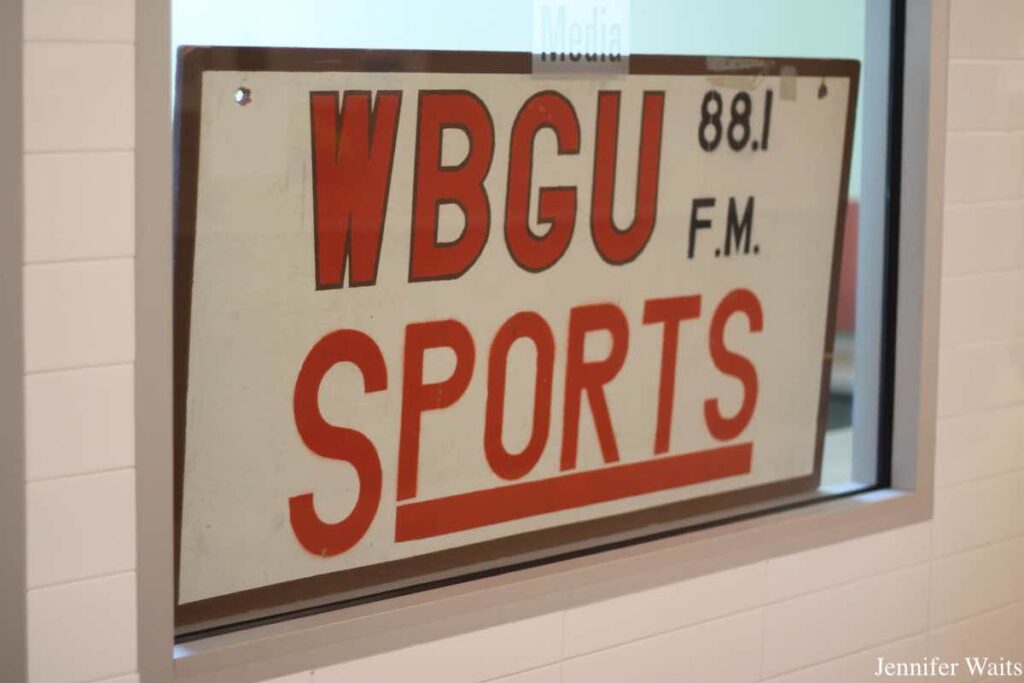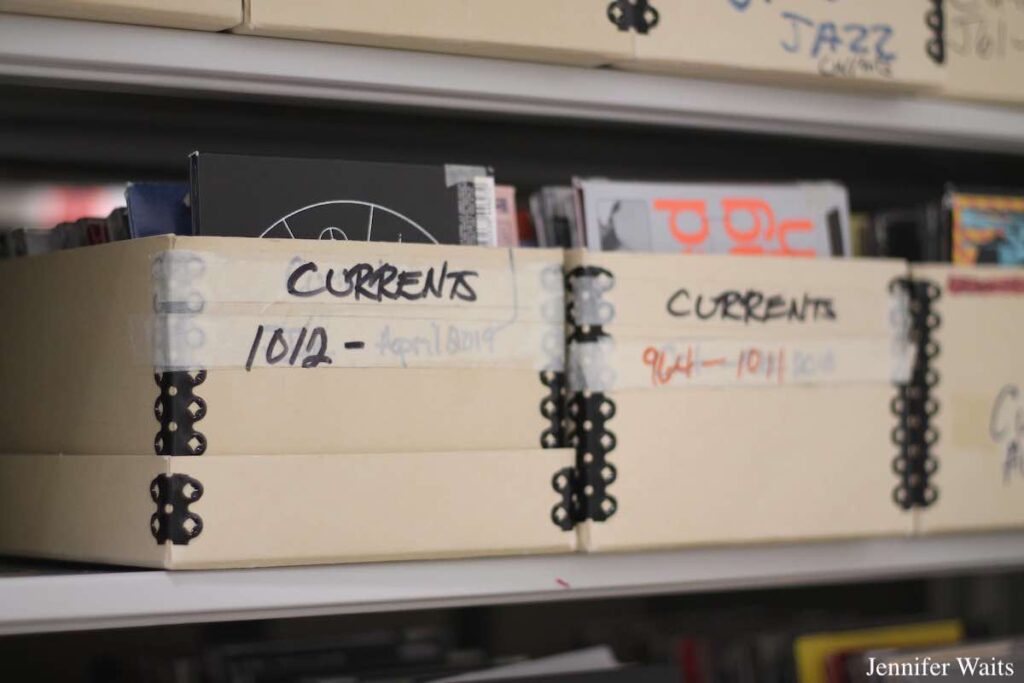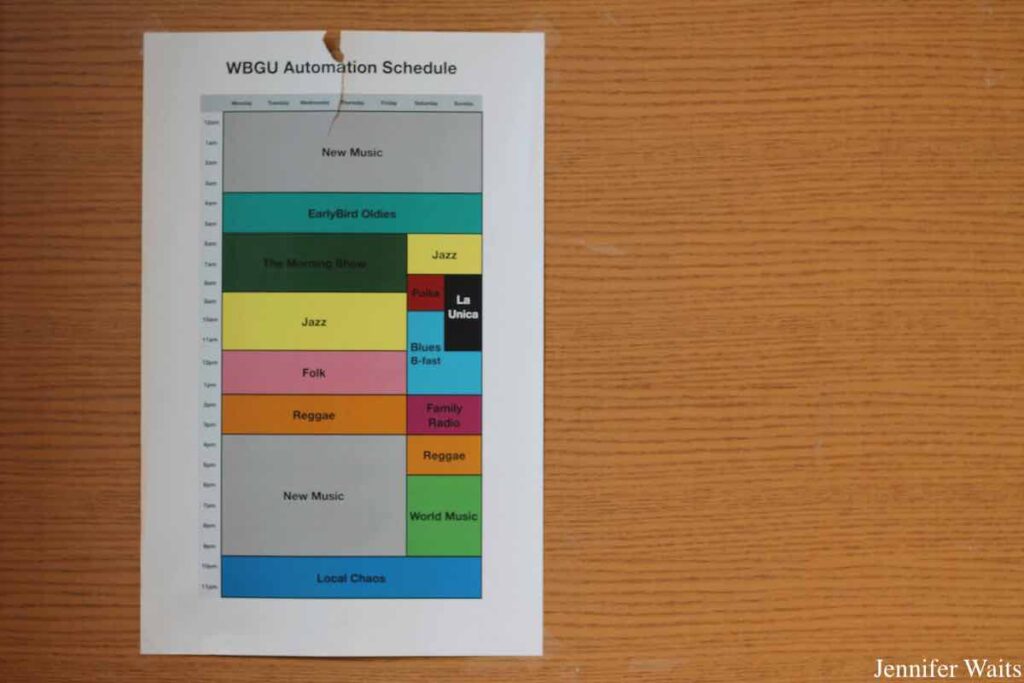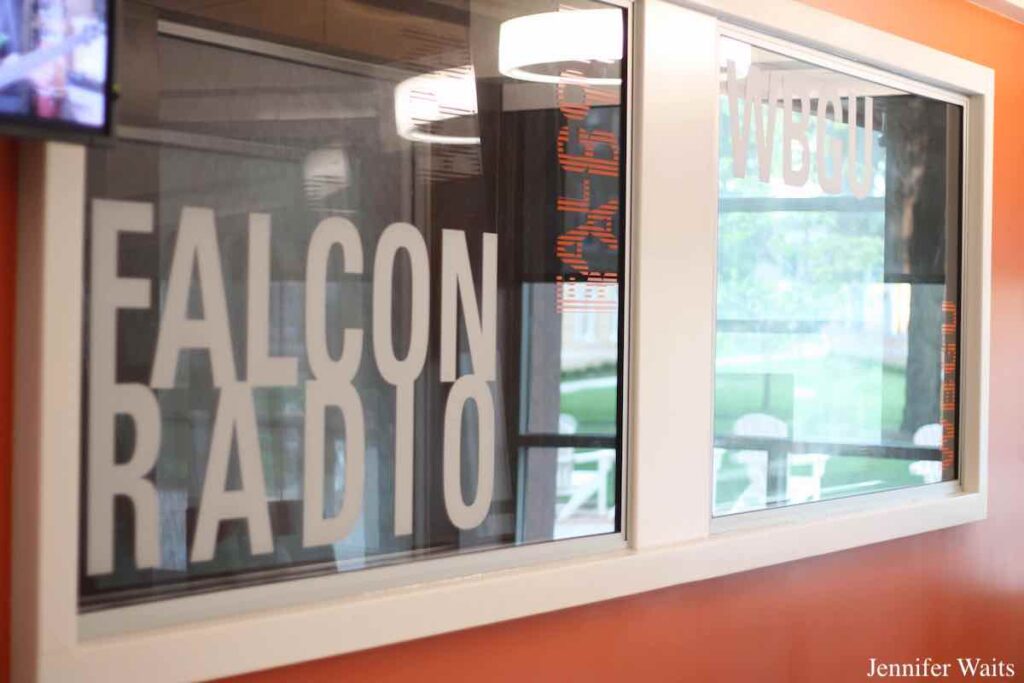It was a surreal experience to return to one of my college radio alma maters, WBGU 88.1 FM at Bowling Green State University (BGSU), and encounter an unrecognizable radio station and campus. Granted it had been nearly 30 years since I’d left northwest Ohio, but I was still surprised by just how much can change. The building that housed WBGU when I was a grad student was torn down in 2017. And the historic house built from a Sears catalog kit that was the headquarters of my graduate department (Popular Culture), was demolished in 2012.
Both spaces hold incredible memories for me of an influential two-year period of my life. I don’t think I’d ever worked harder. I studied, wrote, taught undergraduates, graded papers, DJ’d, saw tons of live music in Ohio and Michigan, and stayed up into the wee hours tallying WBGU playlists to compile charts for weekly submission to CMJ. It was a magical time where I started to truly understand the importance of and power of college radio. MTV News even came to town and interviewed a few of us college radio participants at a local record shop, as they tried to capture a glimpse of the 1990s indie music scene in small town America.
Flashback to WBGU-FM circa 1995-1997
During my stint as a DJ and assistant music director at WBGU-FM, the station was a 1000 watt music-focused non-commercial station with an emphasis on rock, metal, jazz, and hip-hop. In fall 1995, my first semester at the station, evening shows included hip-hop (“Power 88”) several nights a week and metal shows (“Metal Storm”) from midnight to 2am most days. Jazz (“Jazz Unlimited”), reggae, and country shows populated the morning drive time. The rest of the schedule was a mix of mostly rock, with some shows dedicated to punk, hardcore, freeform, techno, world music, folk, womyn in music, sports talk, and more. Live sports coverage also aired on WBGU, sometimes breaking into scheduled music shows.
In the 1990s, the WBGU-FM space in 120 West Hall (on the first floor) included the on-air studio, news/interview booth, a small record library with vinyl and CDs, and an office area. Adjacent to WBGU was a studio for our sister station WFAL-AM (pronounced “waffle”), which was a commercial station broadcasting to the campus dorms using carrier current. My perception at the time was that WBGU functioned like a student club, whereas WFAL had more of a pre-professional orientation. I assumed that WFAL was operated in conjunction with telecommunications classes since WFAL tended to have more news, sports, and mainstream music programming. Digging into the archives, It turns out that some of my assumptions were wrong. WBGU and WFAL both had student leaders. And WFAL’s programming mix was more diverse than I’d realized.

History of College Radio at Bowling Green State University
While a student at Bowling Green, I was completely unaware of the long radio history on campus. The first radio class (“Radio Workshop”) was introduced in 1939 and by 1947, a basketball game was broadcast using a closed-circuit set-up over a public address system. In 1948, campus-only carrier current station WRSM launched at 600 kilocycles, with help from both students and a speech professor. A 1974 piece about Bowling Green radio’s history explains that the call letters were specifically selected by the professor as sort of a voice and diction exercise, as he considered them to be “a tough combination of sounds” for many with mid-western accents.
WRSM’s schedule included music, news, and sports. In January 1949, just a year after its launch, it had a staff of 75 and a music library with more than 900 records. By 1951, an application was filed for an FM license, with WBGU launching that year over 88.1 FM as initially a 10 watt station. Power was increased to 1350 watts in 1959. By the late 1960s, student leadership at WBGU was replaced by “three full-time employees and two graduate assistants in broadcasting.”
WFAL-AM Launches in 1970 as “Alternative Voice”
Because of this change in management at WBGU, campus-only carrier current station WFAL began broadcasts in 1970 as “an alternative voice” for students. While serving as an alternative, it was also designed to be a place where “broadcasting students” could obtain experience in “contemporary, commercial radio.” WFAL initially played primarily Top 40 and progressive music, with specialty shows devoted to oldies, jazz, and comedy. By the 1980s its focus was more pop/rock. And during the 1990s, the schedule also included techno, hip-hop, reggae and more. By 2009, 50% of WFAL’s schedule was hip-hop programming. WFAL dropped its AM carrier current signal in 2008 to broadcast primarily online and eventually stopped using the call letters. The station now goes by the name Falcon Radio.
WBGU-FM’s Shifts in Programming in the 1970s and 1980s
Over the years, programming had many shifts on both WBGU and WFAL. In the 1970s, WBGU-FM had more of community-focus, airing National Public Radio programming, while also broadcasting student-oriented rock music at night. By 1976, the station had lost its NPR affiliation and in the 1980s and 1990s the station seemed to have shifted back to alternative programming led by students. In 1982, WBGU’s program director described the station’s music mix in a letter to the editor of the BG News, saying “WBGU’s prime goal is to serve the community through its programming of alternative music. This also includes jazz, soul, tex mex, country, reggae, plus more.” There were still debates about who the station served. A 1985 letter to editor of the BG News complained that WBGU played music found on commercial radio and was more focused on the community than on students.
By the 1990s, WBGU branded itself as Shark Radio and in addition to its alternative programming, it also produced regular live sports broadcasts. In 1996, WBGU killed off the shark and embraced the mole as its new mascot, describing its kinship with the station’s programming since moles live “underground.” By the early 2000s, WBGU had added a website, which expanded to include not only a webstream, but also a message board in 2002, where fans could chat and obtain news about the station. Shifting to a new URL in 2003, the station maintained its own website at wbgufm.com until fall 2017.
WBGU-FM and Falcon Radio Today
Today, WBGU-FM and Falcon Radio operate under the umbrella of Bowling Green Falcon Media, which also includes BG News (print and web journalism) and BG 24 (video content). The two radio stations now share a website and are located adjacent to each other in the Michael and Sara Kuhlin Center, which opened in Fall 2016. In addition to on-air studios, the space also has production studios. A recording studio in the same building features a control room that connects to the radio station to enable broadcasts of live performances.
Although there weren’t too many students around campus when I visited WBGU-FM on a Wednesday evening in July in 2023; I was able to see radio in action as I sat in on my friend’s show. Rob Sloane, WBGU’s Music Director, is a faculty member and has been an off-and-on WBGU DJ since the 1990s. We met when we were both grad students/DJs at Bowling Green.
As I sat with Rob during his show, he played some old favorites, including staples of our time at WBGU in the 1990s. After popping discs from Yo La Tengo, Guided by Voices, Bis, and Stereolab into the CD player, he jotted down his playlist for his personal archive. Multiple times throughout the show, he gave full weather reports and announced events happening in town. It took me back to my WBGU days, when we had to monitor a weather radio in case we needed to announce alerts and warnings for tornadoes in particular. As a California native, I was terrified of thunderstorms and any hint of a tornado; so having to be a calm voice on the radio in those circumstances was challenging.
The current WBGU studio is light-filled, spacious and modern, surrounded by windows. The ground-floor station overlooks the campus one one side, Falcon Radio’s studio on another, and a hallway with seating on another, allowing visitors to peek into the booth. The lovely view of lush lawns and leafy mature trees felt like it captured not only an iconic collegiate scene, but also a snapshot of a quiet, warm summer night in the mid-west.
After Rob’s show, he gave me a quick tour of WBGU outside of the studio. A lobby opens into the studio space, as well as to several small production booths. A sticker-covered door from the old station is propped along the wall of the lobby and a bulletin board is covered with clippings and flyers. Charming children’s artwork, including a colorful drawing of tulips and music notes, promotes WBGU’s “Family Radio” show. Down the hall, there is also a closet-like record library, with shelves packed with boxes of CDs.
Affixed to the wall of the record library is the “WBGU Vault Indie CD Sign-Out Sheet,” which DJs are asked to fill out if they are checking out CDs to preview for their shows. While the library contains mostly labeled boxes of CDs, there’s also a small collection of vinyl. It’s a greatly reduced library since the station’s days in West Hall and many of the old CDs were sold off for $5 a bag back in 2016 as WBGU was downsizing its collection before the move to the new building.
With community, faculty and student DJs, the current WBGU-FM schedule includes shows devoted to world music, children’s programming, jazz, reggae, blues, polka, folk, punk, new music and more. The Bowling Green Chamber of Commerce runs the “Morning Show,” a weekday morning program that highlights local news, events, sports, community members and organizations.
Thanks to WBGU + Radio Station Tour Archive
Thanks so much to my friend Rob Sloane for the WBGU tour and for allowing me to be a fly on the wall during his show. It was so nostalgic for me to be back on campus. This is my 177th radio station tour report and my 119th college radio station recap. You can peruse all my radio station visits in numerical order or by station type in our archives.




